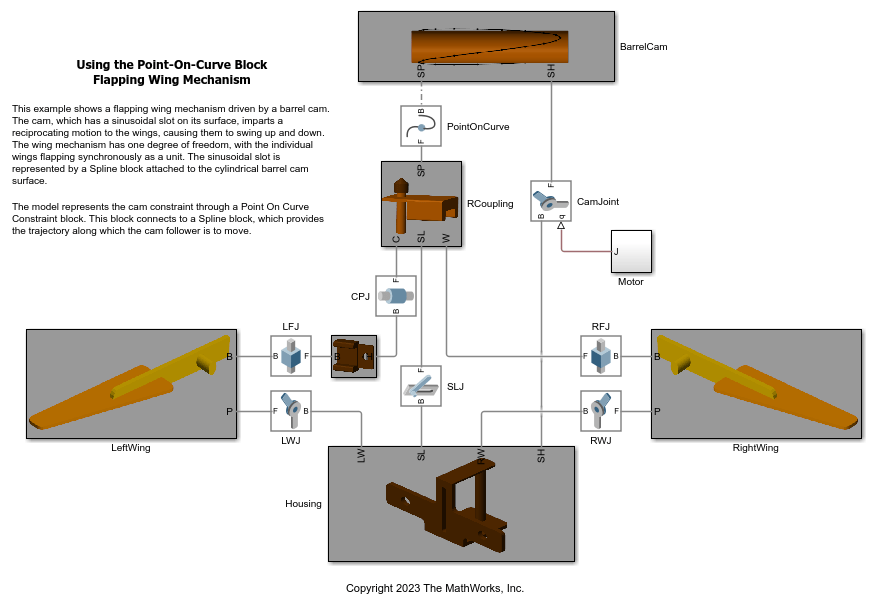Spline
3 次内挿による平面曲線または空間曲線

ライブラリ:
Simscape /
Multibody /
Curves and Surfaces
説明
この Spline ブロックは、指定された点間の 3 次内挿に基づく連続スプライン曲線を作成します。曲線は 2 次元 (平面カム プロファイルなど) または 3 次元 (ローラー コースター トラックなど) のいずれかになります。スプラインの次元は座標行列の次元に依存します。N-by-2 の行列は xy 平面の 2 次元曲線を指定します。N-by-3 の行列は 3 次元曲線を指定します。座標はすべてブロックのローカル基準座標系で解決されます。さらに、指定された端点条件に従って、開いた曲線か閉じた曲線のいずれかになります。

例
Point-On-Curve ブロックの使用:羽ばたく翼の機構
このモデルでは、筒型カムをベースにした羽ばたく翼の機構のシミュレーションを実行します。これは 1 自由度機構で、2 つの翼は互いに対して同期して羽ばたきます。Spline ブロックと Point On Curve ブロックを使用して筒型カム機構をモデル化し、翼の羽ばたく運動を作動させています。
端子
座標系
スプライン曲線の基準座標系。この座標系端子を別のブロックに接続してモデル内でのスプライン曲線の位置と向きを指定します。
ジオメトリ
2 次元または 3 次元の連続スプライン曲線の表現に関連付けられたジオメトリ データ。スプライン曲線の仕様を接続先の他のブロック (Point on Curve Constraint ブロックなど) に提供します。
パラメーター
スプライン曲線を定義するための内挿点の座標を含む行列。2 次元スプラインを指定するには N-by-2 の行列、3 次元スプラインを指定するには N-by-2 の行列を使用します。行列の各行で、Spline ブロックの基準座標系を基準とする内挿点の直交座標を指定します。行列に繰り返し行があるとエラーが発生します。
ヒント
unique 関数を使用して入力行列から繰り返し行を削除できます。
スプライン曲線の端点条件。[Periodic (Closed)] の端点条件は閉じた曲線に対応します。この条件では、ブロックは最初と最後のデータ点を連続した曲線で連結します。[Natural (Open)] の端点条件は開いた曲線に対応します。
スプライン曲線は、端と端が接続された 3 次多項式セグメントの区分的関数です。隣接する多項式セグメントの 1 階微分と 2 階微分が共有する端点において同じになるように曲線が構築されます。
グラフィックス
このスプラインの可視化設定。スプラインを表示するには、既定の設定である [From Geometry] を使用します。球体や座標系などのグラフィックス マーカーを表示するには、[Marker] を選択します。このスプラインの可視化を無効にするには、[None] を選択します。
視覚特性を指定するパラメーター表現。[Diffuse Color] と [Opacity] を指定するには、[Simple] を選択します。[Specular Color]、[Ambient Color]、[Emissive Color]、[Shininess] など、他の視覚特性を指定するには、[Advanced] を選択します。
依存関係
このパラメーターを有効にするには、[Type] を [From Geometry] または [Marker] に設定します。
直接白色光の下でのトゥルーカラー。0 ~ 1 のスケールの [R,G,B] または [R,G,B,A] ベクトルとして指定します。オプションの 4 番目の要素は色の不透明度を 0 ~ 1 のスケールで指定します。不透明度の要素を省略した場合、値 1 を指定したのと同じになります。
依存関係
このパラメーターを有効にするには、[Type] を [From Geometry] または [Marker] に設定します。
グラフィックスの不透明度。0 ~ 1 の範囲のスカラーとして指定します。スカラー 0 は完全な透明を表し、スカラー 1 は完全な不透明を表します。
依存関係
このパラメーターを有効にするには、次のように設定します。
[Type] を
[From Geometry]または[Marker][Visual Properties] を
[Simple]
鏡面反射による光の色。0 ~ 1 の範囲の値をもつ [R,G,B] または [R,G,B,A] ベクトルとして指定します。ベクトルは行ベクトルまたは列ベクトルを使用できます。オプションの 4 番目の要素は色の不透明度を指定します。不透明度の要素を省略した場合、値 1 を指定したのと同じになります。このパラメーターは、反射ハイライト (光源からの光の反射によって描画固体上に生じる明るいスポット) の色を変更します。
依存関係
このパラメーターを有効にするには、次のように設定します。
[Type] を
[From Geometry]または[Marker][Visual Properties] を
[Advanced]
周囲光の色。0 ~ 1 の範囲の値をもつ [R,G,B] または [R,G,B,A] ベクトルとして指定します。ベクトルは行ベクトルまたは列ベクトルを使用できます。オプションの 4 番目の要素は色の不透明度を指定します。不透明度の要素を省略した場合、値 1 を指定したのと同じになります。
周囲光は、光源からの直接光ではない、一般的な照明のレベルを表します。周囲光は、何度も反射を繰り返して特定の方向をもたなくなった光で構成されます。このパラメーターを調整して描画固体の影の色を変更できます。
依存関係
このパラメーターを有効にするには、次のように設定します。
[Type] を
[From Geometry]または[Marker][Visual Properties] を
[Advanced]
自己発光による色。0 ~ 1 の範囲の [R,G,B] または [R,G,B,A] ベクトルとして指定します。ベクトルは行ベクトルまたは列ベクトルを使用できます。オプションの 4 番目の要素は色の不透明度を指定します。不透明度の要素を省略した場合、値 1 を指定したのと同じになります。
発光色は、外部のソースからの色ではない、固体自体から放たれているように見える色です。固体に放射色があれば、外部の光源がなくても固体を認識できます。
依存関係
このパラメーターを有効にするには、次のように設定します。
[Type] を
[From Geometry]または[Marker][Visual Properties] を
[Advanced]
鏡面光反射の鮮鋭度。0 ~ 128 のスケールのスカラーの数値として指定します。光沢の値を大きくすると、範囲の狭いシャープなハイライトとなります。値を小さくすると、範囲の広い滑らかなハイライトとなります。
依存関係
このパラメーターを有効にするには、次のように設定します。
[Type] を
[From Geometry]または[Marker][Visual Properties] を
[Advanced]
グラフィックス マーカーの幾何学的形状。Multibody Explorer に、選択した形状を使用してマーカーが表示されます。
依存関係
このパラメーターを有効にするには、[Type] を [Marker] に設定します。
マーカーの幅 (ピクセル)。この幅はズーム レベルでスケーリングされません。マーカーの表示サイズは画面の解像度に部分的に依存することに注意してください。解像度が高いほど、単位長さあたりのピクセル数が多くなり、それによってアイコンが小さくなります。
依存関係
このパラメーターを有効にするには、[Type] を [Marker] に設定します。
拡張機能
C/C++ コード生成
Simulink® Coder™ を使用して C および C++ コードを生成します。
バージョン履歴
R2015b で導入
MATLAB Command
You clicked a link that corresponds to this MATLAB command:
Run the command by entering it in the MATLAB Command Window. Web browsers do not support MATLAB commands.
Web サイトの選択
Web サイトを選択すると、翻訳されたコンテンツにアクセスし、地域のイベントやサービスを確認できます。現在の位置情報に基づき、次のサイトの選択を推奨します:
また、以下のリストから Web サイトを選択することもできます。
最適なサイトパフォーマンスの取得方法
中国のサイト (中国語または英語) を選択することで、最適なサイトパフォーマンスが得られます。その他の国の MathWorks のサイトは、お客様の地域からのアクセスが最適化されていません。
南北アメリカ
- América Latina (Español)
- Canada (English)
- United States (English)
ヨーロッパ
- Belgium (English)
- Denmark (English)
- Deutschland (Deutsch)
- España (Español)
- Finland (English)
- France (Français)
- Ireland (English)
- Italia (Italiano)
- Luxembourg (English)
- Netherlands (English)
- Norway (English)
- Österreich (Deutsch)
- Portugal (English)
- Sweden (English)
- Switzerland
- United Kingdom (English)
